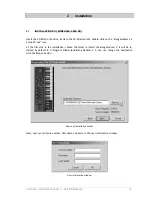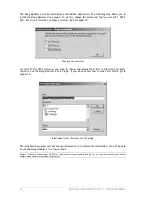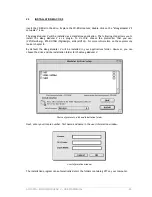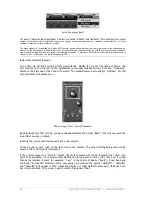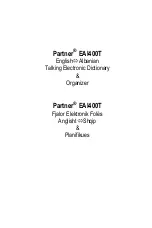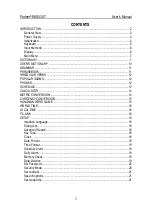
ARTURIA – MOOG MODULAR V – USER’S MANUAL
13
1.2
A MODULAR SYNTHESIZER, WHY?
Why create a modular synthesizer, that is to say comprised of independent modules that we must
connect ourselves, sometimes with difficulty, before obtaining a sound?
The answer, as you can imagine, is very simple: the modularity brings immense possibilities for the
creation of sound.
To convince you, lets look at some basic concepts.
Sound synthesis is essentially based on the use of generators and filters. From these components,
the sound designer must create sounds that can be used by musicians. To succeed, the different pa-
rameters that we have access to (height of note, filter cut-off frequency, output volume, wave
form…) must evolve in time. And for this, we must link different modules between each other.
Let’s take an example: an oscillator, which has inputs to modulate each of its parameters. Let’s
connect the output of an envelope generator to the oscillator frequency modulation input, and
there we get a signal depending on the use of a keyboard. Now we’ll connect a low frequency gen-
erator to the impulse width modulation input and here we have the waveform, which will evolve in
time.
But why not have internal cables, fixed from the start?
Here again, another example will help. Let’s take an envelope and two oscillators. The latter pos-
sess three modulation inputs: a frequency modulation, an impulse width modulation and a volume
modulation.
Effecting every combination with fixed connections would oblige us to have six independent buttons
for the modulation of the parameters.
If we now take 9 oscillators, 6 envelopes, a modulation wheel and a velocity setting, we would
need… 216 setting buttons!
What can we therefore say for the Moog Modular V, which on top of this has three filters, a noise
generator, a sequencer and two control pads!
Connections in a modular synthesizer can sometimes seem difficult, but the often-unexpected re-
sults, are always a source of great musical inspiration.
Either way, don’t worry, the presets created by experienced musicians will allow you, if necessary,
a gentle introduction to the art of sound creation.
This new version presents new modules and a notable improvement to the sound quality and synthe-
sis possibilities. As was the case with the previous versions, it remains faithful to the original Moog
Modulars and offers the possibility to organize the arrangement of certain modules. Ergonomically
this version remains very close to the previous so as not to loose time learning the different func-
tions again.
Содержание Moog Modular V
Страница 1: ...USER S MANUAL Moog Modular V 2 ...
Страница 4: ......
Страница 8: ......
Страница 18: ...18 ARTURIA MOOG MODULAR V USER S MANUAL ...
Страница 52: ...52 ARTURIA MOOG MODULAR V USER S MANUAL ...
Страница 85: ...ARTURIA MOOG MODULAR V USER S MANUAL 85 Independent mode Parallel mode Serial mode ...
Страница 102: ...102 ARTURIA MOOG MODULAR V USER S MANUAL ...
Страница 144: ...144 ARTURIA MOOG MODULAR V USER S MANUAL ...



















